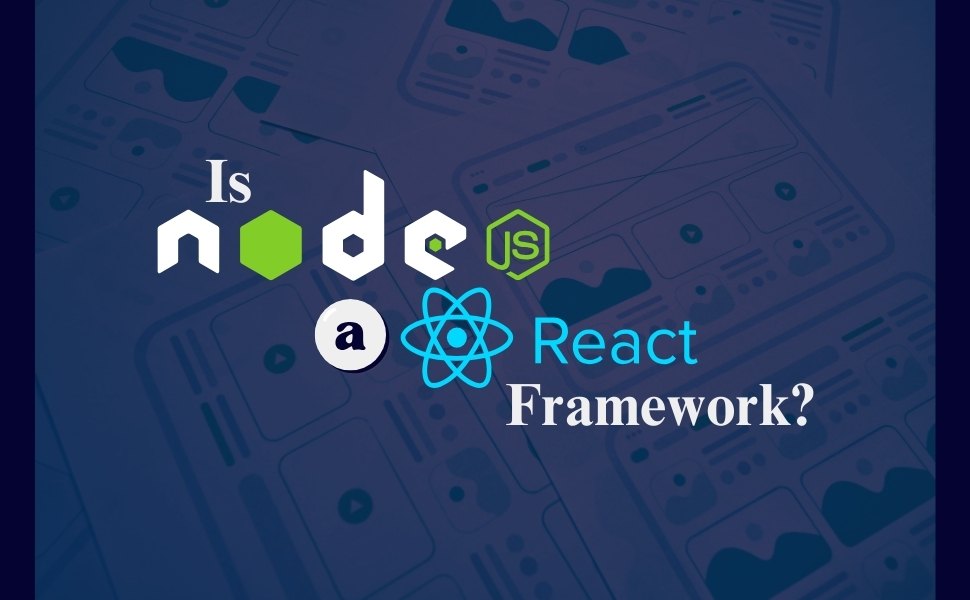Many developers wonder, “Is Node.js a React framework?” This question arises because both technologies use JavaScript and are often seen together in web development. However, when we look at the Node.js vs React debate, it becomes clear that they serve different purposes in frontend vs backend web development.
Node.js is a backend runtime environment that runs JavaScript on the server, handling APIs, databases, and real-time applications. React, on the other hand, is a frontend library for building interactive user interfaces.
To find the answer to “Is Node.js a React framework?”, this guide will explore the Node.js vs React comparison, highlight their differences, and explain how they work together in full-stack development. The Node.js React relationship will help you choose the right tools for your projects.
What is Node.js?

Node.js is a JavaScript runtime environment that lets you run JavaScript outside the browser. This makes it useful for backend development, allowing JavaScript to power servers, APIs, and other backend systems. The Node.js vs React discussion often highlights how Node.js handles server-side logic, while React manages frontend UI development.
Node.js is widely recognized for its speed and efficiency, competing with some of the fastest programming languages in backend development.
Core Features
🔹 Powered by Chrome’s V8 Engine
Node.js runs on the V8 engine, the same engine that powers Google Chrome. This makes it fast and efficient, as it converts JavaScript code into machine code that the computer understands. The Node.js backend React frontend combination is widely used to optimize performance in modern applications.
🔹 Non-Blocking, Event-Driven Architecture
Most traditional servers handle one request at a time, waiting for each one to finish before moving on to the next. Node.js doesn’t wait—it processes multiple requests simultaneously. This makes it lightweight and fast, perfect for apps that need to handle a lot of users at once. Many developers rely on Node.js frameworks for backend solutions, which you can explore in this list of popular Node.js backend frameworks.
🔹 Asynchronous Programming
In Node.js, tasks can happen in the background while other processes continue running. This is done using callbacks, promises, and async/await, which help keep things smooth and efficient. This approach plays a key role in Node.js and React integration, ensuring real-time updates in modern web applications.
Primary Use Cases
🚀 Building Web Servers
Node.js is commonly used to create server-side applications that power websites and apps. Major companies like Netflix, PayPal, and LinkedIn use it to handle millions of users daily. In a Node.js vs React setup, Node.js handles backend logic, while React takes care of the UI.
🌐 Creating APIs
With Node.js, developers can build RESTful APIs and GraphQL backends to manage data and connect different parts of an app. APIs act as messengers, allowing apps and databases to communicate. Node.js is often used in microservices architectures, where an API Gateway in Microservices plays a crucial role in routing and managing API requests efficiently.
💬 Real-Time Applications
Since Node.js handles multiple requests at once, it’s great for real-time applications like chat apps, live streaming, and multiplayer games. The Node.js React integration allows developers to create seamless real-time experiences, where updates happen instantly without refreshing the page. Popular services like WhatsApp and Discord use similar technology to keep conversations and updates instant and smooth. To enhance performance in these applications, developers often apply backend optimization strategies to ensure fast, scalable, and reliable systems.
☁️ Microservices and Cloud-Based Apps
Many companies use Node.js to create microservices, which are small, independent services that work together. These make apps scalable, meaning they can handle more users without slowing down. It’s also widely used for cloud applications, where data is stored and accessed over the internet.
What is React?
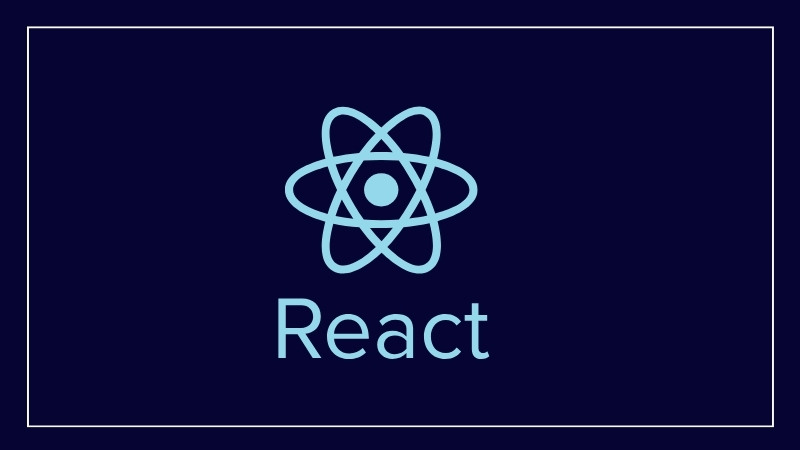
React is a JavaScript library used to build interactive user interfaces. It helps developers create fast, dynamic, and smooth web applications. Instead of reloading an entire page, React updates only the parts that change, making websites feel more responsive and seamless. The Node.js vs React discussion often highlights how React handles the frontend, while Node.js powers the backend.
Core Features
🔹 Component-Based Architecture
In React, everything is built using components—small, reusable pieces of code that manage different parts of a webpage. Think of them like LEGO blocks—you can mix, match, and reuse them to build complex user interfaces without repeating code. This modular approach makes React highly efficient in Node.js and React comparison, as it simplifies frontend development.
When deciding between React and other UI frameworks, it’s helpful to check out this React vs Angular comparison.
🔹 Virtual DOM for Faster Performance
React uses a Virtual DOM (Document Object Model), which is a lightweight copy of the actual webpage. Instead of updating the whole page when something changes, React only updates the changed part, making apps much faster and smoother. The difference between Node.js and React is that React optimizes the frontend UI, while Node.js ensures backend efficiency. It’s essential to know where React fits in the JavaScript ecosystem, and this guide on JavaScript frameworks vs libraries provides clarity on its role.
🔹 One-Way Data Binding for Predictable Behavior
React follows a one-way data flow, meaning data moves in a single direction from one component to another. This makes state management easier and more predictable, reducing errors and simplifying debugging. This structured data flow is a key feature in the Node.js React relationship, as it ensures seamless frontend-backend communication.
Primary Use Cases
🚀 Building Single-Page Applications (SPAs)
React is great for SPAs, where content loads dynamically without refreshing the page. Popular examples include Facebook, Twitter, and Gmail, where users interact with the app in real-time.
🎨 Creating Dynamic and Interactive User Interfaces
React makes it easy to build rich, interactive experiences—like forms that update instantly, buttons that react quickly, and animations that feel smooth. This is a major advantage in the Node.js vs React debate, as React handles the UI. It’s perfect for modern web apps that need a great user experience.
📱 Mobile App Development (React Native)
React isn’t just for websites! With React Native, developers can build mobile apps for iOS and Android using the same React code. This means you can develop once and deploy web and mobile applications everywhere, saving time and effort.
🌍 Server-Side Rendering (SSR) with Next.js
For websites that need faster loading times and better SEO, React can be used with Next.js for server-side rendering (SSR). This helps pages load instantly and improves search engine rankings, making it ideal for blogs, e-commerce sites, and business websites.
Read More: Python vs Node.js: Which One is Better for Backend?
Is Node.js a React Framework?
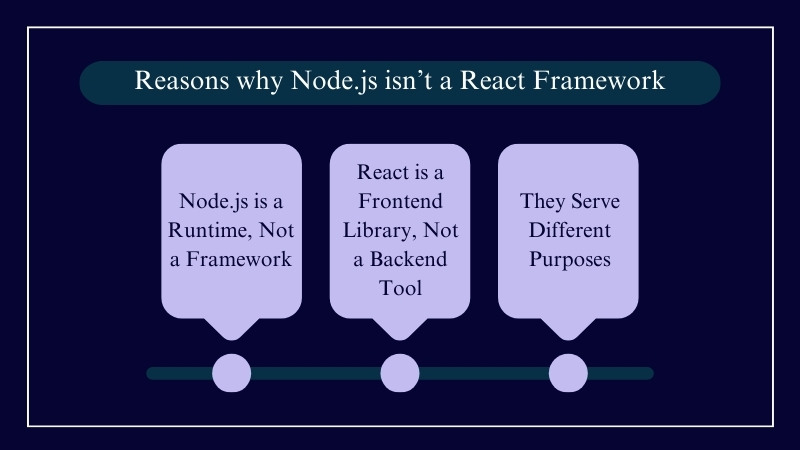
No, Node.js is not a React framework. Many people assume they are connected, but a Node.js vs React comparison shows they have separate roles in web development. While both technologies use JavaScript, they serve different purposes and are not interchangeable.
Explanation
🔹 Node.js is a Runtime, Not a Framework
Node.js is a JavaScript runtime environment. This means it runs JavaScript on the server, allowing developers to build backend applications. It helps power websites by handling data, managing requests, and running scripts outside the browser.
🔹 React is a Frontend Library, Not a Backend Tool
React is a JavaScript library for building interactive user interfaces. It focuses on the frontend—what users see and interact with. Unlike Node.js, React doesn’t handle backend processes like databases or servers. However, in Node.js vs React full-stack development, they work together to create modern web applications.
🔹 They Serve Different Purposes
Node.js helps build the backend (the “behind-the-scenes” part of a web app). On the other hand, React helps build the frontend (the part users see and interact with). They work well together, but they are not the same thing and can’t replace each other.
If you’re building a full-stack application, you might use both Node.js and React. But React doesn’t need Node.js to work, and Node.js doesn’t need React. They are separate tools that developers use for different tasks.
So, if you’re wondering, “Is Node.js a React framework?”, the answer is clear: No, it’s not!
If you’re exploring backend development options, it’s worth considering the best language for backend web development to determine which technology fits your project needs.
Key Differences Between Node.js vs React
While both Node.js and React use JavaScript, their roles in web development are completely different. Node.js powers the backend, while React builds the frontend. Here’s a detailed Node.js vs React comparison—
| Feature | Node.js | React |
|---|---|---|
| Type | A JavaScript runtime environment that allows JavaScript to run outside the browser. | A JavaScript library for building interactive user interfaces. |
| Role | Works as the backend of web applications, handling data, logic, and server-side processes. | Works as the frontend, managing the user interface and interaction. |
| Purpose | Used for server-side development, managing servers, databases, and API requests. | Used for client-side development, creating dynamic and visually appealing user experiences. |
| Dependency | Can work independently without React or any frontend framework. | Needs a frontend environment (browser) or a backend (like Node.js) to function properly. |
| Performance | Fast and scalable, handles many requests simultaneously. | Optimized rendering, updates only the parts of UI that change, improving speed. |
| Flexibility | Can be used with any frontend framework (React, Angular, Vue, etc.). | Best used for UI but can be integrated with different backend technologies. |
| Learning Curve | Easier for developers familiar with JavaScript but requires knowledge of backend concepts like servers, APIs, and databases. | Beginner-friendly for JavaScript users but requires understanding of component-based architecture and state management. |
| Community & Ecosystem | Strong community, extensive libraries, and support for backend development. | Large ecosystem with many third-party tools, active community, and strong frontend support. |
Check out the most in-demand backend frameworks to see where Node.js stands among other options. Additionally, knowing the right backend programming language for your project can help you make the best choice.
How Node.js and React Work Together
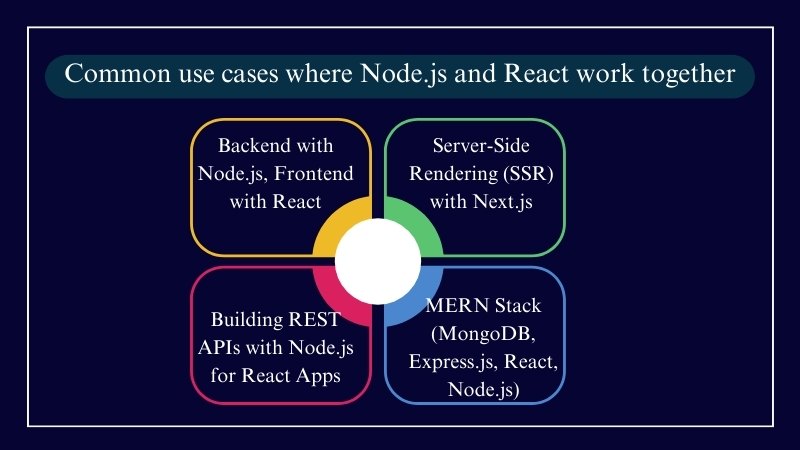
Although Node.js vs React highlights their differences, they are often used together in full-stack web development. Node.js handles the backend, processing data and managing APIs, while React builds the frontend, delivering a dynamic user experience.
Let’s explore some common use cases where Node.js and React work together—
🔹 Backend with Node.js, Frontend with React
In a full-stack JavaScript application, Node.js powers the backend, managing server requests, databases, and user authentication. Meanwhile, React handles the frontend, displaying the UI and ensuring a smooth user experience. For example, an e-commerce website may use Node.js for processing payments and React for showing product listings.
🔹 Server-Side Rendering (SSR) with Next.js
Normally, React apps render content in the browser, but this can be slow and bad for SEO. By using Next.js (a React framework) with Node.js, pages are rendered on the server before being sent to the browser. This makes websites faster and more SEO-friendly, which is great for blogs, news sites, and e-commerce platforms.
If you’re wondering about Next.js’s role in development, you might explore whether Next.js is frontend or backend to understand its flexibility.
🔹 Building REST APIs with Node.js for React Apps
A REST API acts as a bridge between the frontend and backend. Node.js creates the API, handling data storage, user authentication, and business logic. React then fetches this data and displays it on the UI. This setup is commonly used in social media apps, dashboards, and weather apps where data needs to be updated frequently.
🔹 MERN Stack (MongoDB, Express.js, React, Node.js)
The MERN stack is a popular full-stack JavaScript framework that combines—
✅ MongoDB – A NoSQL database for storing data.
✅ Express.js – A lightweight web framework for building APIs.
✅ React – The frontend UI library.
✅ Node.js – The backend runtime.
Together, they allow developers to build powerful, full-stack web applications using only JavaScript. Many startups and large companies use MERN to create scalable web apps like project management tools, online learning platforms, and social networking sites. This combination allows developers to build fast, scalable, and dynamic web apps, aligning with the best practices in the web development project life cycle.
Why Do People Confuse Node.js with a React Framework?
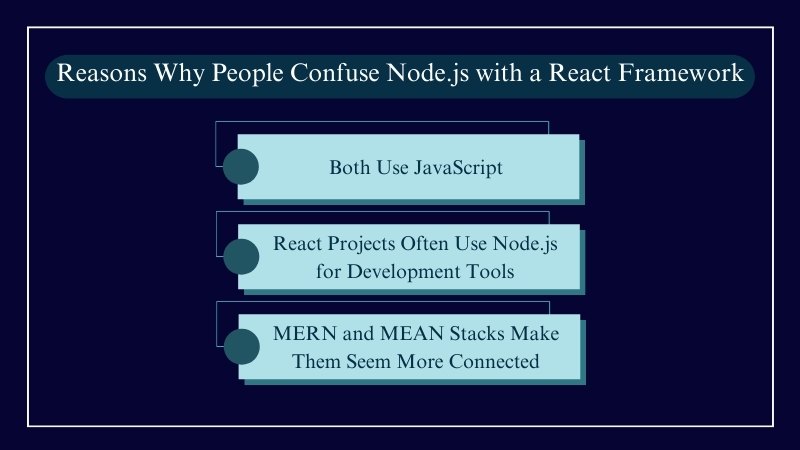
Many beginners mistakenly believe that Node.js is a React framework. This confusion happens for a few key reasons—
🔹 Both Use JavaScript
Since both Node.js and React are JavaScript-based, many assume they must be closely connected. While they can work together, they serve completely different purposes—Node.js is for backend development, while React is for frontend UI.
Similarly, other frontend frameworks like Angular are often compared with React. If you’re interested in how Angular differs from React, explore some of the top Angular features.
🔹 React Projects Often Use Node.js for Development Tools
Even if a React app doesn’t use Node.js in production, Node.js is often required during development. Developers use npm (Node Package Manager), Webpack, and Babel—all of which run on Node.js—to install dependencies and optimize their React apps. This makes it seem like Node.js is part of React, when in reality, it’s just a helpful tool.
🔹 MERN and MEAN Stacks Make Them Seem More Connected
Popular full-stack JavaScript frameworks like MERN (MongoDB, Express.js, React, Node.js) and MEAN (MongoDB, Express.js, Angular, Node.js) use both Node.js and React (or Angular). This makes it appear as if Node.js and React are tightly linked, but in reality, they work independently and can be replaced with other technologies.
Get Expert Help from BoomDevs for Seamless Node.js and React Development
When it comes to Node.js vs React, the real magic happens when they work together seamlessly. At BoomDevs, we specialize in crafting high-performance, scalable, and interactive applications where Node.js powers the backend and React drives the frontend—effortlessly.
🔥 Why Choose BoomDevs?
💡 Smart Full-Stack Solutions – Tailored Node.js backend React frontend architectures for smooth functionality.
⚡ Seamless Integration – Optimized Node.js and React integration for ultra-fast, responsive apps.
📈 Performance & SEO Mastery – Using Next.js, SSR, and scalable Node.js APIs for better speed and search rankings.
🔗 End-to-End Development – From backend logic to stunning UI, we handle it all.
Your ideas deserve more than just code—they need expert execution. Let’s build something that’s powerful, efficient, and future-proof.
Reach Out Today!
Bring your Node.js vs React project to life.
Closing Thought
Node.js is not a React framework. While both use JavaScript, they serve different roles—Node.js powers the backend, handling servers and APIs, while React builds the frontend, creating interactive user interfaces.
Though separate, they work well together in full-stack development. If you’re building a complete web app, using Node.js for the backend and React for the frontend is a powerful and efficient choice.
By leveraging both, developers can create fast, scalable, and modern web applications with ease. If you’re planning to develop a web project, it’s crucial to understand the entire process from start to finish—check out the ultimate website planning guide to ensure your project is set up for success!



